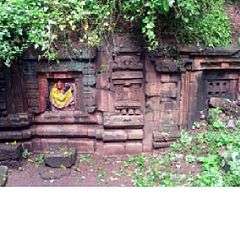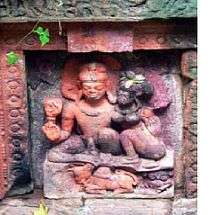Narayani Temple
| Narayani Temple | |
|---|---|
 | |
 Narayani Temple Location in Orissa | |
| Geography | |
| Coordinates | 20°14′35″N 85°50′06″E / 20.24306°N 85.83500°ECoordinates: 20°14′35″N 85°50′06″E / 20.24306°N 85.83500°E |
| Country | India |
| State | Orissa |
| Locale | Bhubaneswar |
| Elevation | 23 m (75 ft) |
| Culture | |
| Primary deity | Durga |
| Architecture | |
| Architectural styles | Kalingan Style (Kalinga Architecture) |
| History and governance | |
| Date built | 7th century A.D. |
Narayani Temple is dedicated to ten armed goddess Narayani or Lakshmi and is located in Narayani village situated near Khalikote, Orissa, India. The temple is popular for Durga Puja and a fair held in the Indian month of Chaitra. The temple was renovated by the zamindars of Khalikote in the early 18th century. The style of the temple is a Khakhara Deula, like Vaital Deula. It is supposed to have existed before 12th Century AD. The temple is known for the scenic beauty of the surrounding countryside' including Chilika Lake.
Location
Lat. 20014’35" N., Long. 850 50’ 06"E., Elev. 75 ft Narayani temple is situated within the precinct of Bhabani Sankara temple which is located on the left side of the Tala Bazar road leading from Lingaraja temple to Bindusagar. It is 15.00 metres east of Sari deul, 20.00 metres north-east of Suka temple, 5.00 metres Northeast of Arjuneswara temple and behind the Bhabani Sankar temple. The temple was totally buried and was partly exposed by an excavation conducted by Debala Mitra.
Age
Precise date : 7th Century A.D.
Approximate date: Bhauma epoch.
Source of Information : Pabhaga three mouldings, rectangular jagamohana with features of Parasurameswara of 7th century A.D. It was first noticed by Charles Fabri and partly exposed by D. Mitra. Now only a part of the eastern wall and southern wall is visible beneath a Sanskrit College under the name Krushna Chandra Gurukula Vidyapitha.
Property Type

Precinct/ Building/ Structure/Landscape/Site/Tank: Precinct. Subtype: Temple.
Property use
i) Abandoned/ in use: Abandoned.
ii) Present use: Non living
iii) Past use: Worshipped.
Physical description
Surrounding
The temple is buried below the Sanskrit College behind the Bhabani Sankar Temple.
Orientation
Facing towards North. 308
Architectural features (Plan and Elevation)
The visible parts of the temple measure 6.75 metres in length and 4.35 metres in width. The bada that is visible has threefold division namely pabhaga with three mouldings (0.85 metres), Jangha (1.55 metres) and baranda (0.33 metres).
Raha niche & parsva devatas
In the western wall of the vimana, raha niche is visible that measures 0.80 metres in height, 0.85 metres width and 0.20 metres in depth. It houses a panel of Uma-mahesvara.
Decorative features
The khura is inscribed in south wall decorated with four decorated vertical pilasters with chaitya medalions as similar with south wall bada of the vaital temple. The eastern wall is decorated with two vertical pilasters on either sides of raha niche. Within the pilaster there is a subsidiary niche with scroll works measures 0.35 metres height x 0.22 metres width and 0.05 metres in depth decorated with elephant and lion heads surmounted by lotus design. The niche crowned with a vajramundi at the center of which a peeping human face. Above the niche there is a stylised chaitya. The baranda portion decorated with muktalobhi hansa flanked by two stylised chaitya. The jagamohana is a rectangular hall in shape decorated with three baluster windows, one measures 1.20 metres in height and 1.00 metres in width except this the jagamohana is devoid of ornamentation. The jambs of niche is decorated with three vertical bands of scroll works like lotus leaf, beaded design and floral motif from exterior to interior flanked by two vertical pilasters. At the base and top of the pilaster decorated with ghata pallava with scroll design. The temple is totally buried from three sides only eastern side excarated which is visible originally temple has doorjambs but at present it was buried.
Building material
Sandstone.
Construction techniques
Dry masonry
Style
Kalingan
State of preservation
Good/Fair/ Showing Signs of Deterioration/Advanced: The temple is totally buried. Traces of the bada are only visible. Superstructure has collapsed.
Condition description
Signs of distress: The temple is broken from the bada
Grade (A/B/C)
i) Architecture: A
ii) Historic: A
iii) Associational: A
iv) Social/Cultural: A
Threats to the property
Conservation Problem and Remedies: The temple is covered with wild vegetation which is furthering the process of deterioration.
References
External links
- reports on Narayani
- images of Narayani Temple
- Lesser Known Monuments of Bhubaneswar by Dr. Sadasiba Pradhan (ISBN 81-7375-164-1)
- http://www.aparnatravels.com/chilika-narayani.htm
- http://ignca.nic.in/asp/showbig.asp?projid=orkhr1320001
- http://ignca.nic.in/img_0002_as_or_khurda.htm
- http://www.temples.ind.in/temples/temples-in.../hindu-temples-of-orissa.htm
- List of Hindu temples in India#Orissa
